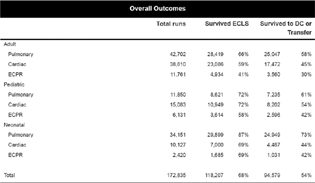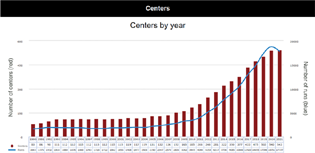Translate this page into:
Extracorporeal Life Support Organization Registry Report 2022
Peter Rycus, MSc ELSO (The Extracorporeal Life Support Organization) Ann Arbor, Michigan 48109 United States prycus@elso.org
This article was originally published by Thieme Medical and Scientific Publishers Pvt. Ltd. and was migrated to Scientific Scholar after the change of Publisher.
History of Extracorporeal Life Support Organization
The Extracorporeal Life Support Organization (ELSO) was formed in 1989 as a group of centers that were actively using extracorporeal life support (ECLS) in the management of cardiopulmonary failure. Among the functions of ELSO are enhancing communication, developing guidelines for ECLS, and maintaining a registry of ECLS cases. In 2021, ELSO had 543 domestic and international centers who actively report data to the registry.1
Maintaining a registry of ECLS cases is one of the major functions of ELSO. Entry of patient data into the registry is strongly encouraged to all ELSO members. Initially the registry was implemented as a system of handwritten paper forms filled out by individual centers that were manually entered at ELSO into a flat file database. Recognizing the growth of ECLS and the needs of ELSO members, the registry has evolved into a secure, encrypted web-based data entry system with integrated data integrity monitoring that stores data in a Microsoft SQL Server (Microsoft Corporation, Redmond, Washington, United States). Addition of disease- and condition-specific data, including specific surgical information for the cardiac support patients, International Classification of Diseases, 10th version (ICD-10), and current procedural terminology values to the database, allows a standard structure that promotes consistency in query results. This modernization has provided multiple benefits to the ELSO registry and the ECLS community. It has allowed a more rapid response to urgent clinically needed queries of the database.
Additionally, it allows for rapid collection and distribution of worldwide outcome data as was seen during the coronavirus disease 2019 pandemic. Standardized reporting of both international and center-specific patient outcomes and complications is reported to centers member twice a year. The ECLS registry is among the most important functions of ELSO. Data reported to ELSO include basic patient descriptive information, perinatal information (for neonatal patients), pre-ECLS physiologic data, ECLS equipment and implementation data, complications (both mechanical and patient related), and outcome information. In addition to that data, for specific patient conditions, addendums have been created for cardiac failure patients (2001 with planned 2023 update), Extracorporeal Cardiopulmonary Resuscitation (ECPR) (2011 and updated in 2022), and trauma (2022). The ELSO registry has collected important information on ECLS use for centers worldwide and has helped understand ECLS use and outcomes. Variables collected in the registry have been recently revised to include pre-ECLS severity of illness, ICD-10 diagnosis and procedure codes, and newer adverse event variables. These changes will hopefully help enhance our understanding of severity of illness before ECLS and its influence on ECLS survival, as well as changing trends. The registry categorizes cases as neonatal, pediatric, or adult. Neonatal cases are defined as those aged 28 days or less at the time of ECLS initiation. Pediatric cases are those over 28 days old but still younger than 18 years old. Adult cases include the population of patients aged 18 years old and older.
The ELSO registry is a comprehensive database of extracorporeal support data and remains a valuable resource to the ECLS community, clinicians, industry, and regulatory agencies. In response to the changing populations and numbers of patients being treated with ECLS, additions are being made to the current ELSO registry infrastructure. The recent addition of XML data import with automatic data integrity monitoring will lower the barrier to data entry, thus improving response rates, and aid in ensuring accuracy of the entered values.
The year 2022 brings a few important upgrades to the main ELSO registry and the addition of one voluntary Addenda. These upgrades are:
-
Updates to the addition of new equipment, device replacement reasons, and associated mechanical complications to resolve and prevent entry of discordant device replacement reasons with run complications along with the interface for adding new equipment
-
Updated workflow surrounding patients transferred on ECLS between centers to more succinctly match patients and minimize the potential for confusion at the point of data entry.
These upgrades have been motivated by the goals of increasing ELSO registry data integrity and value while decreasing confusion at the point of data entry. ELSO is positive in improving ECLS globally at each step.
As of December 1, 2021, new discrepancies cannot be added to the ELSO registry. At the point of entry, the ELSO Data Manager notified the data being entered is discrepant and cannot be entered. Each warning message is specific to the given discrepancy. If an ELSO center entered an ECMO run with a discrepancy between January 1, 2020 and December 1, 2021, ELSO emailed the center identifying the discrepancy of the equipment exchange. Those with discrepancies were requested they fix the issues. If centers did not fix the discrepancy, then they were notified as of December 17th those runs were changed to uncommitted. All of the data remains in the registry, but the run will not contribute to center statistics regarding survival or complication reports until the discrepancy is resolved. Analogous considerations apply for pump exchanges. The latest ELSO registry report is given in Figs. 1 and 2.2

- Overall outcomes. DC, Discharge; ECLS, extracorporeal life support.

- Centers of Extracorporeal Life Support Organization.
Conflict of Interest
None declared.
References
- Extracorporeal Life Support Organization Registry Report 2012. ASAIO J. 2013;59(3):202-210.
- [Google Scholar]
- Accessed September 13, 2022, at:
- [Publisher]





